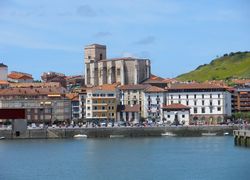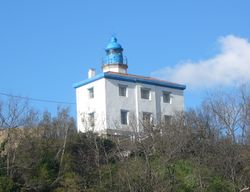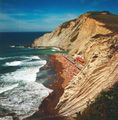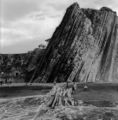سومايا
Zumaia | |
|---|---|
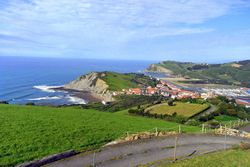 | |
| الإحداثيات: 43°17′50″N 2°15′25″W / 43.29722°N 2.25694°W | |
| Country | |
| Autonomous community | |
| Province | Gipuzkoa |
| Comarca | Urola Costa |
| تأسست | 1347 |
| الحكومة | |
| • العمدة | Oier Korta Esnal (PNV) |
| المساحة | |
| • الإجمالي | 11٫28 كم² (4٫36 ميل²) |
| التعداد ()[1] | |
| صفة المواطن | باسكية: zumaiarra |
| منطقة التوقيت | UTC+1 (CET) |
| • الصيف (التوقيت الصيفي) | UTC+2 (CEST) |
| Postal code | 20750 |
| مفتاح الهاتف | +34 (Spain) + 943 (Gipuzkoa) |
| الموقع الإلكتروني | zumaia.eus |
سومايا (باسكية: Zumaia؛ [s̻umaja], إسپانية: Zumaya) is a small town in the north of Spain in the Basque Country.
The town has two beaches (Itzurun and Santiago), which are of interest to geologists because they are situated among the longest set of continuous rock strata in the world. Known locally as the "flysch" they date from the mid-cretaceous period to the present, a time period of over 100 million years. The K-T boundary is present at the Itzurun beach, and fossils can be found, notably of ammonites. The strata stretches along a distance of about 8 km, between the towns/beaches of Deba and Getaria, with Zumaia lying in the middle.
The town is also the home/museum of the painter Ignacio Zuloaga. Exhibits include works by El Greco, Rivera, Zurbarán and Goya. Across the street there is a museum of craft and hand-crafted products of Laia. Within the city centre, the Basque-style Gothic church of San Pedro can be found. It has a temple with a magnificent reredos by Juan de Antxieta, the only work by this Basque sculptor found in Gipuzkoa.
Zumaia is located at the point where the Urola and Narrondo rivers come together. The origins of the town can be traced by its ancient monastery. In the Middle Ages, the people who lived in the Sehatz valley having to endure the continuous attacks of pirates and pillagers, fortified the city. The church today retains the relic of its defensive appearance.
سومايا والأخطبوط
The Octopus and Zumaia have been together since the early days of the creation of the town. There has been a special relation between this animal and the town in which other towns, in Getaria, Zarautz or Deba (which they are 5, 10 and 16 km from Zumaia), has never occurred. The tradition of catching octopuses on the coastline of Zumaia has been very typical, and the octopus has become the essence of the culture and tradition of the town.
معرض الصور
Lighthouse of Zumaia
Chapel of San Telmo
References
- "Guía monumental (historia y arte) de Zumaia Guipúzcoa". Arte Guías.
- Romatet, J.L (October 2014). "Dena ez da Olagarro Zopa". Baleike. 236: 13–17.
- Zabaleta, Gorka (September 2012). "Zumaia eta Olagarroa". Baleike. 213: 6–17.
- Romatet, J.L (15 October 2012). "Zumaia eta Olagarroa: Maitasun istorio bat". Diario Vasco.
External links
- Pages using gadget WikiMiniAtlas
- CS1 errors: empty citation
- Articles with hatnote templates targeting a nonexistent page
- Missing redirects
- Short description is different from Wikidata
- Coordinates on Wikidata
- Pages using Template:Spain metadata Wikidata without references
- Articles containing باسكية-language text
- Pages using Lang-xx templates
- Pages using infobox settlement with unknown parameters
- Articles containing إسپانية-language text
- Municipalities in Gipuzkoa
- Populated places in Gipuzkoa
- Fishing villages




